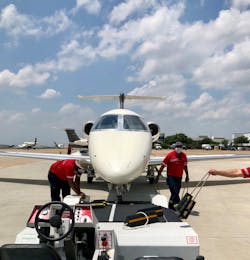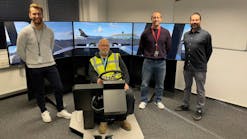The Trouble with Tribal Knowledge
Tribal knowledge takes its name from before humans had written language and information could only be shared with a tribe orally. The concept has become something of a thorn in the side of present-day businesses. While oral traditions and unwritten rules are inescapable human tendencies, that does not mean the practices are without danger.
In safety-critical environments, knowledge must be shared accurately with the latest protocols and proper training behind it; so when it’s time for action, people aren’t operating on what they think the “norms” are.
It’s these norms that Keith Clark, quality control and technical support rep, Phillips 66 Aviation, says tribal knowledge on the ramp becomes cemented into.
“Some people would describe tribal knowledge as ‘norms,’ which is one of the 12 human factors. Practices that can develop over time can be both good and bad, safe and unsafe; they are referred to as ‘the way we do things round here’ and become norms,” Clark describes.
Clark continues that because aviation is such a constantly shifting industry, the norms of yesterday may not be relevant today. It requires ongoing education and training to keep up with the latest. But as Clark warns, not every employee may be willing or able to do that.
“Some veteran employees in the industry might be too set in their ways and lack ongoing education and training, and they fail to realize that they’re doing something incorrectly,” Clark says.
If this employee is then in charge of teaching new or younger employees, the cycle continues as they spread the potentially harmful tribal knowledge to those who may not know any better.
“Because of that, I worry about somebody with 30 years just like I worry about someone with 6 months experience,” Clark continues.
Michael France, NATA’s managing director of safety and training, echoes Clark’s concerns, adding: “The most dangerous thing is when you release your new employee out into the wild and the old, grizzled veteran puts his arm around him and says, ‘look, let me show you how we really do things around here.’”
To combat the ease at which misinformation can propagate via tribal knowledge and norms, NATA created the Safety 1st Training program, which provides standardized training and educational resources. Prior to the inception of the program, France says the tribal knowledge method was a primary way of training.
“The experienced guy would relay what he knew about fueling airplanes and how the equipment worked and so on, to the new hires. The company might have some things written down, but there wasn't this industry-wide storehouse of information and knowledge,” France says.
Having a collection of information like the Safety 1st Training program fights back against what France says is one of the key dangers of tribal knowledge – not knowing what you don’t know. In other words, an organization can be ignorant of what the norms have become and just what knowledge it is that employees are operating with, all the while assuming everything is fine.
In hand with that is also the risk of people hoarding the knowledge they have in order to put themselves in a position of power, France says. And if this hoarded knowledge is never shared or recorded in an official capacity, an organization can lose it forever when that employee leaves or retires – realizing once he or she is gone that nobody now knows how that employee did that job.
It all adds up to a lot of risk for an organization.
“All of that flows up into your culture. What is the culture of your organization? How do things function from a change management perspective? Now you have a real issue. Let's say you want to do something differently. If you don't know how you're actually doing it, or why it's happening, or what's driving existing processes, it becomes nearly impossible to make improvements,” says France.
Learning What You Know
If tribal knowledge is understood to be the unwritten rules and norms between employees, then getting that information down on paper and standardized is a critical first step to getting an organization back in line. It’s all about documentation says Bob Schick, director of operations support, TAC Air.
“Document it, document it and document it,” emphasizes Schick. “If it’s written down then everyone in the process has the same recipe for success. If the recipe needs to be changed, that change is institutionalized for the next employee coming into the organization.”
Schick notes that tribal knowledge is not always a negative, with experience and lessons learned being turned into efficiency and future success by an employee.
“The benefit of this knowledge is that the organization can operate at optimum levels because the seasoned workers know the task,” Schick adds. “The advantage of tribal knowledge in training is that it’s usually how the job really gets done including all the shortcuts that the trainer has learned along the way.”
Schick says that rarely, though, is that information passed onto the next generation correctly, resulting in repeating mistakes from the past, which the organization thought were already put to rest.
For this reason, the need to have processes documented and checked against industry-standard training and safety protocols becomes crucial.
“Check what they know and do against the written standard. Audit what they are doing for accuracy and compliance and then evaluate if that process is really getting the job done as intended,” adds Schick.
Checking against industry standards is one step, with the other being ongoing instruction, adds Clark.
“I always encourage FBOs to guard against incorrect tribal knowledge by committing to ongoing education and training. They need to be willing to constantly learn and recognize that ongoing education is a critical part of the job,” Clark says.
To get team members onboard with continual education and training and to make individuals eager to share the knowledge they have, France says an organization needs to make their efforts internal and collaborative. It’s important to realize that everyone, from the CEO to the frontline employees, has valuable experience they can contribute to be catalogued.
“That can be as simple as understanding and taking the time to observe how tasks are actually being completed on a regular basis. Is the processes that management thinks are occurring out on the ramp really what's happening? Or do they vary some? And some of that variance might actually be good, so you've got to capture that,” France continues.
He adds that communication, therefore, is critical, whether that is holding monthly safety meetings and reviewing operations, or instituting non-punitive hazard reporting so employees can feel safe speaking up when they think a new or existing policy or procedure poses a risk itself.
France warns, though, that this shouldn’t come in the form of rigid, inflexible policy and procedure from the top that doesn’t actually fit a significant portion of the operations.
“Yes, there needs to be firm guardrails that say, ‘this is a do not cross line right here.’ But being able to have that conversation and allow for the feedback to come back to managers and the folks that are writing policy can go a long way. Because the most surefire way to get deviation from a policy is to create a rigid inflexible policy and procedure without input from all stakeholders,” France says.
“Employees should feel empowered to ask questions,” adds Clark. “Ask why or how, even for the simplest things. If an employee hears something differently in training, or if they’ve read something different, question it. We encourage the Phillips 66 branded network of FBOs to always reference the training materials provided by the industry and reach out if you have a question.”
For veteran workers, they should be routinely self-evaluating to make sure they haven’t ingrained any functional, but unsafe, work habits by reviewing the processes and latest guidelines. Clark says veterans shouldn’t be afraid to admit they don’t know everything and keep current with the latest by asking questions even if they feel they should know the answer.
“They should assume that things have changed. They should maintain constant training and education. They should take a hard look at the things they’ve been doing for the past 20 years and wonder if they’ve been doing it that way ‘just because that’s how it’s always been done,’” Clark adds.
An effective way for long-time employees to stay current is to take on training roles.
“Employees with more experience should serve in a training role,” says Clark. “If they’re responsible for training others, then it’s more of their responsibility to ensure they’re teaching the most accurate and up-to-date guidelines.”








